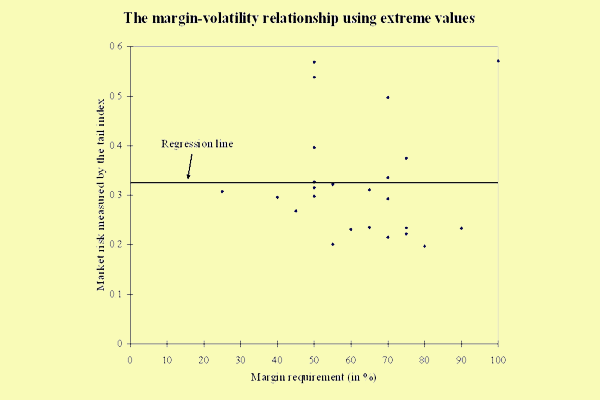

Do margin requirements reduce stock price volatility? The stock market boom of the late 1920s and the Great Crash of 1929 indeed prompted Congress to pass the Securities and Exchange Act of 1934 which gave the Fed authority to regulate and control credit in the stock market. Regulators thought that easy credit for buying on margin during the boom and liquidation of shares in response to margin calls during the crash played a significant role in large swings of market prices. Since that time the Fed has been changing margin levels in the belief that raising margins reduces stock price volatility. The level of margin has not been changed for more than two decades now while empirical tests by academics and regulatory economists showed that the impact of margins on volatility was not convincing. The stock market crash of 1987 recently renewed interest in increasing margin requirements to prevent the occurrence of such another near-apocalyptic event.
Recent academic studies revived the academic debate by finding a significant negative relationship between official initial margin requirement and stock market return variance used as a proxy for volatility. That paper provoked other studies which led to the opposite conclusion using different specifications of the variance. Conclusions about the impact of margin on volatility then appear sensitive to the measurement of how market prices move.
The contribution of this paper is to propose a different risk measure in order to reexamine the margin-volatility relationship. I propose a new measure explicitly focusing on extreme price movements. All previous studies classically used the variance to measure risk. Based on the statistical theory of extreme values I use the tail index to assess the weight of the distribution of extreme returns. This new approach is largely motivated by the focus on stock market booms and crashes in the debate over margin regulation. Using data of U.S. equity prices and margin level covering the time-period 1885-1990, I use regression techniques to test the relationship.

As suggested by the figure above, the main result of this empirical exercise is that there is no convincing evidence that the level of initial margin requirements affects the level of volatility measured by the weight of extreme price movements in the distribution.
 Return to the publication list
Return to the publication list
The asymptotic distribution of extreme stock market returns
From VaR to stress testing : the extreme value approach
Winning in the best and worst of times : boom and crash options